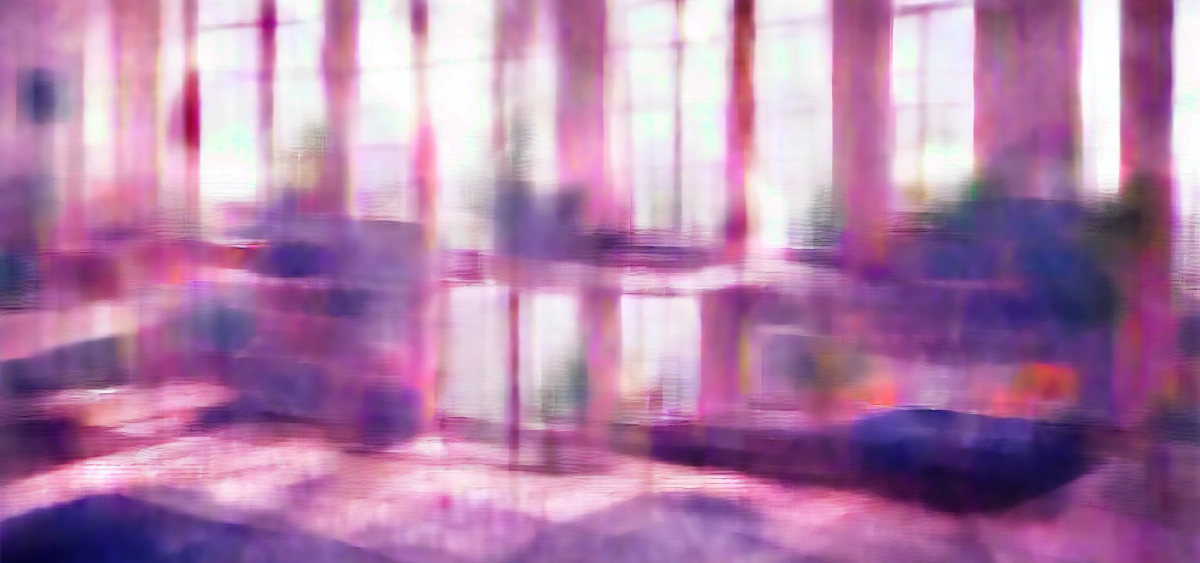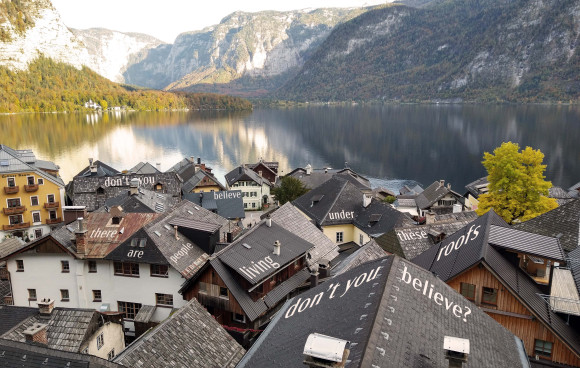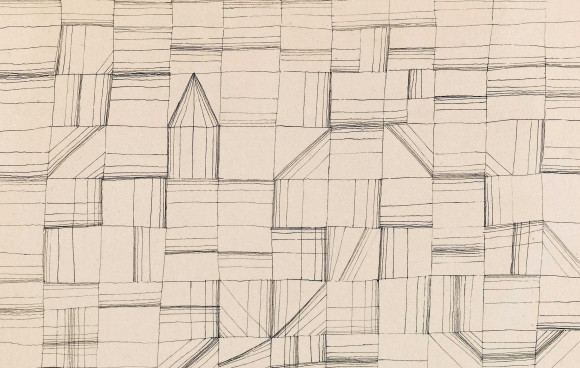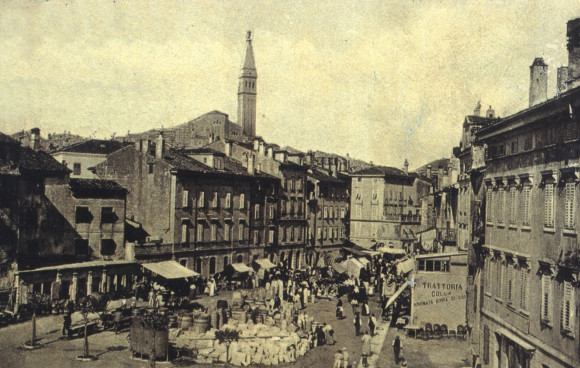Entwerfen
AI - Drawing Housing Otherwise
AI - Drawing Housing Otherwise
Exploring the Home Through Image-based AI Tools
In times of multiple crises, the so-called polycrises, the profession of architecture must rethink itself. Nearly 40% of CO2 emissions are related to the building sector, the climate breakdown has a clear link to architecture. There is an urgent need to do things differently, especially in the field of housing. In this context, the Design Studio "AI - Drawing Housing Otherwise" aims to rethink housing, the home, and how we live together. How can we navigate from an exploitative, commodified, monotonous form of living, which is causing harm to both the human and non-human environment, to a home that seeks for multiplicity, diversity, resistance, and spatial justice?
We want to explore other possible futures of the home through the production of images. “Drawing Otherwise” is therefore a critical, activist, embodied practice — a moment of questioning dominant principles in existing living conditions and at the same time making this questioning visible through new images. It's not just about visualizing a different idea of what a home might look like; it's about developing another architecture through the act of drawing. We are interested in images that are in the process of being made, instead of being statically fixed; images that do not displace lived realities or outsource certain topics such as reproductive labour, power structures or conflict; images that tell other stories of living by embracing glitches, cracks and contradictions in dominant narratives of dwelling.
The impact of images, particularly in the field of architecture, is often underestimated. But images themselves become forms of representation that produce different cultures of evidence and forms of historiography and thereby shaping social norms. Images not only represent reality; they also co-produce it. For better or for worse, we are entering an age in which images and media representations of people, cities, and territories are very powerful. We can take this opportunity to engage with images as a form of reality and experiment, explore, and test versions of living together through them. In this Design Studio, we want to explore if Artificial Intelligence-based image generators like DALL·E, Midjourney, or Stable Diffusion could help to explore other forms of the home.
AI is everywhere, infiltrating various aspects of our daily lives. From facial recognition and social media feeds to self-driving cars and home automation. AI is radically changing the way we relate to each other and our environment, and architecture is no exception. When we talk about artificial intelligence, we are referring to algorithms that can evaluate vast amounts of data and create new content such as images, text, code, or audio. The rapid development of AI over the past two years, exemplified by the launch of Open AI's user-friendly chatbot ChatGPT in November 2022, has introduced AI to the wide public.
In the Design Studio, we will explore AI diffusion models, these generative text-to-image tools use artificial intelligence to generate images in response to text prompts written by their users. With the launch of Midjourney in 2022 anybody with an internet connection could create detailed images on whatever topic in a matter of seconds, from futuristic worlds to the pope in an oversized coat. These models learn visual aspects like shadow play, shapes, and representation of patterns and objects by training data sets. AI models are typically viewed as closed systems, beginning with a data set and ending with predictions. But as we exist in a digital landscape filled with human biases—navigating these image generators requires careful reflection.
Midjourney and ChatGPT's knowledge is acquired by reading data from millions of websites, reflecting the current state of internet data. To what extent can human biases find their way into AI systems, with harmful consequences? “The world according to Stable Diffusion is run by white male CEOs, women are rarely doctors, lawyers or judges, men with dark skin commit crimes, while women with dark skin flip burgers.” So, do we end up reinforcing stereotypical images with Western-centric monoculture under a false guise of democratization? Miriam Hillawi Abraham emphasizes the opportunities and dangers in the digital realm, “My work is driven by the idea of using storytelling and world-building to approximate realities that are not necessarily ideal, perfect, or utopian but instead disrupt our dysfunctional present and allow us to consider multiplicities and alternatives so that we do not merely exist as passive subjects to our futures.”
All AI image generators are text-based on the code level. So, the role of language within the creative process will gain importance. Will there be prompt designers in the future, specialized in the relationship between language and architecture? Or are we confronted with the limits of language in describing what makes a home? There will be many questions and uncertainties when working and exploring AI in the field of architecture. But architecture is never just a building, it is also the discourse and process that defines it: So how are digital tools and artificial intelligence changing the way we think, plan, design, develop, and build space and architecture? Questions of biased data collection, ownership, liability, deep-fakes and authorship also need to be discussed.
Maybe we also need to rethink our anthropocentric bias that everything (including creativity) is grounded in human beings. A design process could also be a tentacular collaboration between people, programs, algorithms, groups and images. Furthermore, it is crucial to understand the functions of AI tools and the business model behind them to be able to operate with them. The platform/tool is not a neutral medium; it comes with histories, biases, intentions, and goals. Even if they stand for transparency, openness, and progress, AI technologies can be a wild "mixture of violence and candy-sweet fairy tales"(Keller Easterling).
In the Design Studio "AI - Drawing Housing Otherwise," we will experiment with AI tools to generate image artefacts and rework them both analogue and digital. It will be a collaborative or hybrid network established of human and non-human actors, working together creatively. This Design Studio is NOT looking for cliché images of a paternalistic, technopositive, and colonial utopian future images, nor is it interested in endless feedback loops of look-alike images of the work of deceased architects.
We want to work with AI tools to experiment and explore a counter-housing knowledge through them. Is AI helpful and to what extent, or does it still reproduce dominant forms of representation of the home found on platforms like Instagram, where the home is displayed in endless repetitions of perfectly aestheticized staged images? There must be more than the endless Masquerades of spatial products (Keller Easterling) that follow familiar commercial logics. Can we transform, change and relearn housing knowledge through AI images?
Is it possible to "hack" the logic of biased data sets? What could a queer AI achieve, based on a feminist understanding of knowledge, always particular, ambiguous, and incomplete? AI is often used for efficiency, but we want to explore the charm of the unplanned, surprising combinations of the known and the unknown, the things/spaces/homes we cannot see yet. Digital media is a powerful, playful, and unrestrained way to imagine and create scenarios for alternative futures of living together.
This Design Studio "AI - Drawing Housing Otherwise" is an experiment, a testing site, and a breeding ground. We will produce a wild visual atlas of possible futures of living together drawn by many. We welcome students interested in digital technology and its effects on human perception. Students who want to explore a counter-housing knowledge of the domestic space and enjoy experimenting with images in all their variations.
All genders and nationalities are welcome! (We aim for gender balance in the studio.)
NO prior technical knowledge of AI tools is required!
Studio language: German (English if required).
Registration via pool.
This design studio is conducted by Dr. Bernadette Krejs and tutor Sebastian Pichler.
There will be two workshop sessions, wonderful guests and a joyful unlearning!
Kick-off: March 14, 2024; Final presentation: May 23, 2024.
Thursday 10 a.m. - 2 p.m, Seminarraum Wohnbau
Do 14.3. / 01_Kick Off
Do 21.3. / 02_Meeting
Do 11.4. - Fr. 12.4 / 03_Workshop I
Do. 18.4. / 04_Meeting
Do. 25.4 / 05 Midterms
Do. 2.5. - 3.5 / 06 Workshop II
Do. 16.5. / 07_Meeting
Do. 23.5 / 08_Finals
4.0h, 5 ECTS
FINAL PRESENTATION 23.5.
Portfolio erwünscht
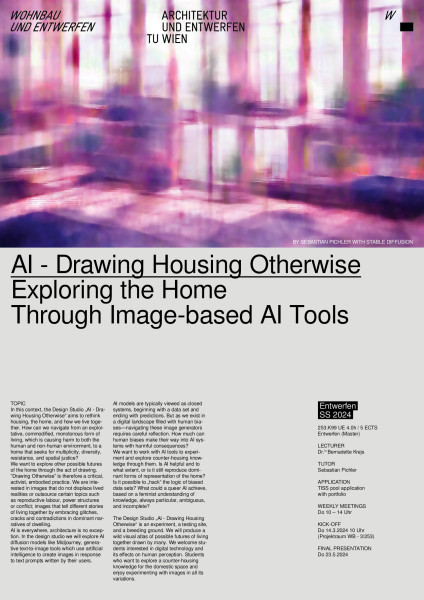
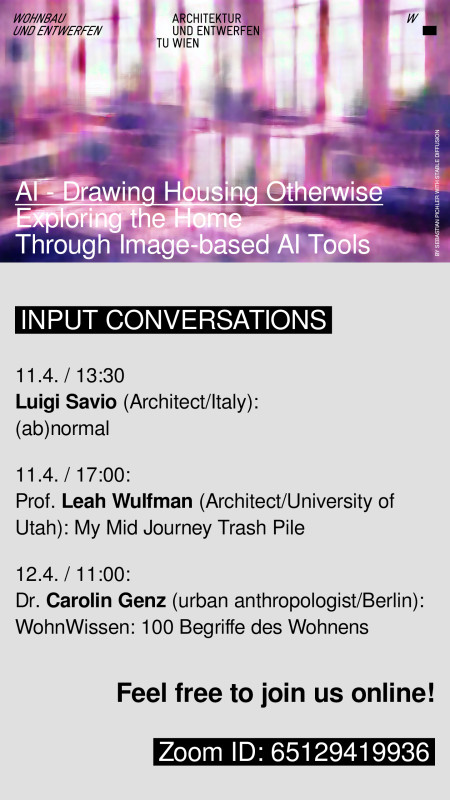
https://tuwien.zoom.us/j/65129419936
Deutsch
AI - Drawing Housing Otherwise
Exploring the Home Through Image-based AI Tools
Angesichts der Polykrisen muss der Berufsstand der Architekten umdenken, der Klimazusammenbruch hat einen klaren Bezug zur Architektur. Es besteht die dringende Notwendigkeit, Architektur anders zu machen, insbesondere im Bereich des Wohnens.
In diesem Zusammenhang zielt das Designstudio "AI - Drawing Housing Otherwise" darauf ab, das Wohnen, unser Zuhause und die Art und Weise, wie wir zusammenleben, neu zu überdenken. Wie können wir von einer ausbeuterischen, kommodifizierten, monotonen Form des Wohnens, die sowohl der menschlichen als auch der nicht-menschlichen Umwelt schadet, zu einem Wohnen übergehen, das nach Vielfalt, Diversität, Widerstand und räumlicher Gerechtigkeit für alle strebt?
Wir wollen durch den Akt des Zeichnens andere mögliche Zukünfte des Wohnens erkunden. "Drawing Otherwise" ist eine kritisch aktivistische Praxis. Wir interessieren uns für Bilder, die gelebte Realitäten nicht verdrängen oder bestimmte Themen wie Reproduktionsarbeit, Machtstrukturen oder Konflikte auslagern; wir suchen nach Wohnbildwelten, die andere Geschichten des Zusammenlebens erzählen, indem sie Glitches, Cracks und Widersprüche in den vorherrschenden Narrativen des Wohnens aufgreifen und zur Diskussion stellen.
Die Wirkung von Bildern, insbesondere im Bereich der Architektur, wird oft unterschätzt, aber Bilder zeigen die Realität nicht nur, sie produzieren sie auch mit. Wir können diese Gelegenheit nutzen, um uns mit Bildern zu beschäftigen und mit ihnen zu experimentieren, sie zu erforschen und durch sie Versionen des Zusammenlebens auszutesten. In diesem Design Studio wollen wir untersuchen, ob auf künstlicher Intelligenz basierende Software wie DALL-E, Midjourney oder Stable Diffusion dazu beitragen können, andere Formen des Wohnens zu erforschen.
KI ist überall, Architektur ist hier keine Ausnahme. KI infiltriert verschiedene Aspekte unseres täglichen Lebens - von Gesichtserkennung und Social Media Feeds bis hin zu selbstfahrenden Autos und Hausautomatisierung - und wurde 2022 mit dem benutzerfreundlichen Chatbot ChatGPT für eine breiten Öffentlichkeit zugänglich. Im Designstudio werden wir KI-Difusionmodelle wie Midjourney erforschen, die generative Text-zu-Bild-Tools sind und mit künstliche Intelligenz Bilder erzeugen, die auf Text Promt ihren Nutzer*innen basieren. Die Rolle der Sprache im kreativen Prozess wird also an Bedeutung gewinnen. Wird es in Zukunft Prompt-Designer geben, die auf die Beziehung zwischen Sprache und Architektur spezialisiert sind? Oder werden wir bei der Beschreibung dessen, was Wohnen ausmacht, mit den Grenzen der Sprache konfrontiert?
KI-Modelle werden normalerweise als geschlossene Systeme betrachtet, die mit einem Datensatz beginnen und mit Vorhersagen enden. Wir bewegen uns jedoch in einer digitalen Landschaft, die von menschlichen Vorurteilen geprägt ist, eine kritische Auseinandersetzung mit Ki-Bildsoftware ist daher notwendig. Inwieweit kann menschliches Bias in KI-Systeme einfließen und schwerwiegende Folgen mit sich bringen? “The world according to Stable Diffusion is run by white male CEOs, women are rarely doctors, lawyers or judges, men with dark skin commit crimes, while women with dark skin flip burgers.” Verstärken wir also am Ende die stereotypen Bilder mit einer westlich-zentrierten Monokultur unter dem falschen Deckmantel der Demokratisierung? Und vielleicht müssen wir auch unsere anthropozentrische Sichtweise überdenken, dass alles (einschließlich Kreativität) ausschließlich auf den Menschen zurückzuführen ist; ein Entwurfsprozess könnte auch eine tentakuläre Zusammenarbeit zwischen Menschen, Programmen, Algorithmen und unterschiedlichen Gruppen sein.
Wir wollen mit KI-Tools experimentieren und erforschen, ob durch diese andere Wohnwissensbestände produziert werden können? Ist KI hilfreich und in welchem Ausmaß, oder reproduziert sie lediglich dominante Formen der Repräsentation des Wohnens? Es muss mehr geben als die endlosen Maskeraden von Raumprodukten (Keller Easterling), die bekannten kommerziellen Logiken folgen. Können wir das Wissen über das Wohnen durch KI-Bilder transformieren, verändern und neu erlernen? Ist es möglich, die Logik von voreingenommenen Datensätzen zu "hacken"? Was könnte eine queere KI leisten, die auf einem feministischen Verständnis von Wissen basiert, das immer partikular, mehrdeutig und unvollständig ist? KI wird oft aus Effizienzgründen eingesetzt, aber wir wollen den Charme des Ungeplanten, überraschende Kombinationen von Bekanntem und Unbekanntem sowie Räume, die wir noch nicht sehen können, erkunden.
Das Designstudio "AI - Drawing Housing Otherwise" ist ein Experiment. Wir werden einen wilden visuellen Atlas möglicher Zukünfte des Zusammenlebens erstellen, der von vielen gezeichnet wird. Wir heißen Studenten willkommen, die sich für digitale Technologie und ihre Auswirkungen auf die menschliche Wahrnehmung interessieren. Studierende, die ein Gegen-Wohnungswissen im Wohnen erforschen wollen und mit Bildern in allen Variationen experimentieren wollen.
